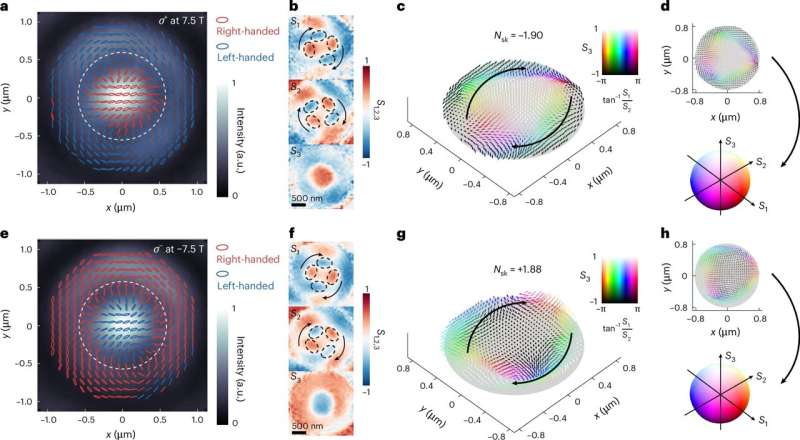Skyrmions are localized, particle-like excitations in materials that retain their structure due to topological constraints (i.e., restrictions arising from properties that remain unchanged under smooth deformations). These quasiparticles, first introduced in high-energy physics and quantum field theory, have since attracted intense interest in condensed matter physics and photonics, owing to their potential as robust carriers for information storage and manipulation.
Researchers at Sun Yat-sen University and Tianjin University recently reported the first experimental realization of single-photon quantum skyrmions (i.e., localized light structures) in a semiconductor cavity quantum electrodynamics (QED) system. Their paper, published in Nature Physics, could open new possibilities for the study of quantum light-matter interactions, while also contributing to the advancement of photonic quantum devices.
“Our work was motivated by the longstanding challenge of realizing topological photonic structures—specifically skyrmions—at the quantum level,” Ying Yu, co-senior author of the paper, told Phys.org.
“While optical skyrmions have been demonstrated in classical optics using bulk setups, creating them with single photons on a chip-scale platform remained an open problem. We aimed to bridge this gap by leveraging solid-state cavity quantum electrodynamics (cQED) with engineered spin–orbit coupling to generate single-photon skyrmions.”
The main objective of this recent study by Yu and his colleagues was to realize quantum skyrmions using a deterministically coupled quantum dot-based microcavity system. In addition, the team wished to explore the topological properties of these quasiparticles and assess their robustness against perturbations.
“We designed and fabricated a semiconductor-dielectric Gaussian microcavity with strong photonic spin–orbit coupling, which supports skyrmionics cavity modes,” explained Yu.

“These modes are carefully engineered superpositions of Laguerre-Gaussian states that carry orbital angular momentum, which is essential for forming skyrmions. By embedding a single InAs quantum dot at the center of this cavity under magnetic fields, we were able to selectively couple the dot’s emission with circular polarization to specific cavity modes and generate single photons whose polarization states form skyrmionic textures.”
To realize quantum optical skyrmions, the researchers thus employed a combination of various technologies and experimental techniques. The most notable among these were a precisely designed microcavity system, the careful positioning of quantum dots in this system and the collection of polarization-resolved single-photon measurements.
“We were the first to experimentally realize quantum optical skyrmions—single photons that carry skyrmionic polarization textures—on an integrated nanophotonic platform,” said Yu. “Beyond demonstrating their deterministic generation, we also verified their topological invariance under optical perturbations.”
This recent study by Yu and his colleagues could open new valuable possibilities for the development of quantum photonic systems and chiral quantum optics. In the future, the newly realized quantum skyrmions could be leveraged to develop quantum information systems, high-dimensional quantum communication protocols and topologically protected quantum memories.
As part of their next studies, the researchers hope to realize other skyrmionics structures using similar experimental techniques. For instance, they would like to realize skyrmioniums, composite topological structures with a tunable topology that could prove valuable for the advancement of spintronic and quantum devices.
“We are also finding ways to generate entanglement between polarization and skyrmions on a single photon without external magnetic fields,” added Yu.
“Additionally, we aim to integrate these devices into scalable photonic circuits, potentially enabling new architectures for quantum computing and information processing. We are also investigating the use of anisotropic and chiral materials to further control and diversify the topological features of emitted photons.”
Written for you by our author Ingrid Fadelli, edited by Gaby Clark, and fact-checked and reviewed by Robert Egan—this article is the result of careful human work. We rely on readers like you to keep independent science journalism alive.
If this reporting matters to you,
please consider a donation (especially monthly).
You’ll get an ad-free account as a thank-you.
More information:
Jiantao Ma et al, Nanophotonic quantum skyrmions enabled by semiconductor cavity quantum electrodynamics, Nature Physics (2025). DOI: 10.1038/s41567-025-02973-y.
© 2025 Science X Network
Citation:
The first experimental realization of quantum optical skyrmions in a semiconductor QED system (2025, August 13)
retrieved 13 August 2025
from
This document is subject to copyright. Apart from any fair dealing for the purpose of private study or research, no
part may be reproduced without the written permission. The content is provided for information purposes only.

